The first step we are going to take is to know the etymological origin of the term leukocytes that concerns us now. In that case, we have to state that it is a word that derives from Greek, specifically it is the result of the sum of two lexical components of said language that are well differentiated:
-The word "leukos", which means "white."
-The noun "kytos", which is synonymous with "cell".
Likewise, it must be taken into account that it is considered that the first time that there is documentation and evidence of the use of the term leukocytes was in the second half of the 19th century. Specifically, it appeared in 1855 in the revision of the work "Dicctionaire de médicine, de chirurgie, de pharmacie...", written by Pierre Hubert and whose aforementioned revision was carried out by the French Charles Philippe Robin and Émile MP Littré.
In Spain, for its part, the first time that this term has been documented was in 1896 in a Spanish dictionary made by Elías Zerolo.
Leukocytes , also called white blood cells , are colorless or whitish cells found in lymph and blood. They have the function of defending the body from various types of antigens.
 In charge of executing the immune response , leukocytes are produced in the lymphatic tissue and bone marrow. The amount detected in the body through a laboratory analysis can reveal the existence of different diseases when the values are not normal.
In charge of executing the immune response , leukocytes are produced in the lymphatic tissue and bone marrow. The amount detected in the body through a laboratory analysis can reveal the existence of different diseases when the values are not normal.
It is considered that a human being should have between 4,000 and 11,000 leukocytes per microliter of blood . When the level is lower, a disorder known as leukopenia occurs; However, if the level is higher, it is a case of leukocytosis . Both leukopenia and leukocytosis can be symptoms of different health problems, such as infections or poisoning.
In the same way, we have to establish that, as a general rule, abnormal leukocyte results make it clear that the person who has undergone the blood test may have different health problems. Thus, specifically, you can suffer from rheumatoid arthritis to thyroiditis through acute stress, gout, leukemia, rheumatic fever or trauma, for example.
However, these abnormal results may also be because that individual is undergoing chemotherapy or radiotherapy treatment, for example.
It should be noted that the cellular components of blood are called formed or figurative elements . These components are platelets , red blood cells ( red blood cells ) and leukocytes ( white blood cells ).
Lacking pigments, leukocytes are white. These cells have a nucleus and mitochondria, among other organelles, and can move thanks to their pseudopodia.
Through diapedesis , leukocytes extend their cytoplasmic contents and can escape from the blood vessels. In this way they come into contact with the tissues found inside the body.
Lymphocytes , monocytes , neutrophils , basophils and eosinophils are different types of leukocytes. Each one has different functions: while eosinophils act in infections caused by parasites, neutrophils gain prominence in infections caused by fungi or bacteria , for example.
